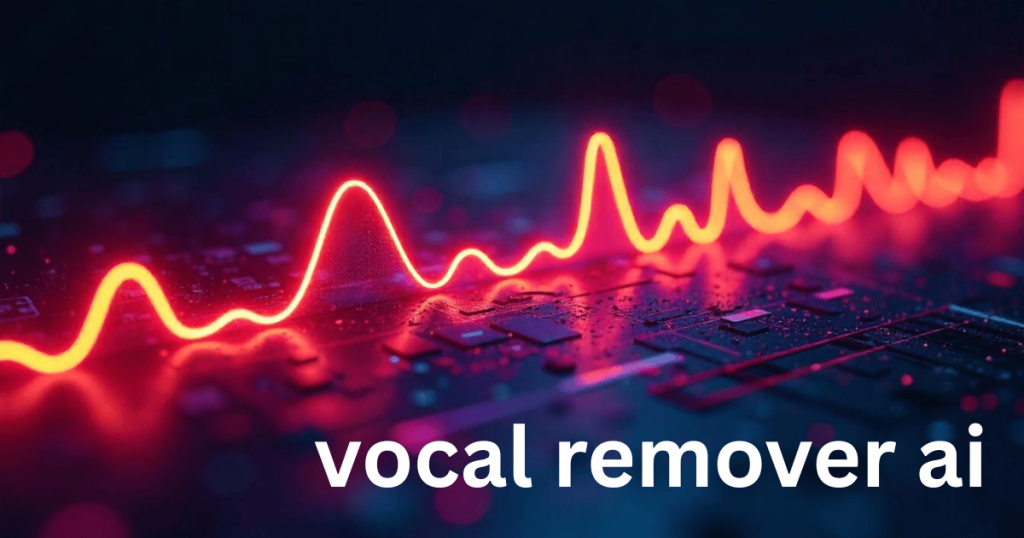The way we’re tearing apart beats these days isn’t just evolution—it’s a full-blown cultural carnage. Gone are the days when the only way to dissect a track was by painstakingly slicing through analog tapes or overloading dusty samplers. Today, you’re staring down the barrel of something far more radical: AI stem splitter, the audio splitter that’s rewriting the rules of music. This is the gritty guide to mastering the art of using beats to rap on an AI audio stem splitter and vocal remover—an exploration as uncompromising as the streets that birthed hip-hop and as technologically charged as Silicon Valley’s wild dreams.
There’s a twisted, beautiful irony in a tool that can isolate vocals at the speed of thought—a tool that, in one part, promises freedom and, in another, threatens to render the very craft of production a relic. We’re riding the line between creative genius and mechanized convenience, and the debate is as raw as any underground cypher. In a world where every beat can be deconstructed by a stem splitter free tool, we must ask: are we preserving the art, or are we dismantling its soul?
Ripping the Beat Apart: The New Frontier of Audio Stem Splitters
Step into any modern studio or DIY setup, and you’ll see an array of software boasting about their ability to “separate vocals from music” with a single click. But behind the glossy interface of the latest AI vocal splitter is a complex dance between algorithms and creativity, a dance where the traditional rules of sampling and live performance collide with digital wizardry. The heart of this revolution is the stem splitter free tool—not just for the technically inclined, but for anyone brave enough to remodel sound.
Picture this: you’ve got a track that pulses with raw energy—a beat laden with aggression, heartfelt lyrics crammed in under layers of soulful chords. You want to isolate vocals, carve out the instrumentals, and reassemble them in a way that tells your own story. With the new wave of AI splitter tools, this is not only possible—it’s damn accessible. The vocal remover AI doesn’t just erase the singer; it lets the underlying structures breathe, serving up a cocktail of separated tracks that are as pure as they are chaotic. Suddenly, the musical landscape becomes a canvas where every isolated element is a brushstroke in a sprawling, audacious mural.
Breaking Down the Beast: How It Works
The real magic behind the audio stem splitter isn’t some hocus-pocus software sorcery—it’s math, machine learning, and a dash of modern rebellion. At its core, the process is about analysis. These systems dissect a track using deep neural networks, identifying frequencies, patterns, and the intricate interplay between vocals and instruments. The AI vocal splitter leverages datasets built on countless hours of sound to “learn” what a vocal sounds like versus a snare hit or a bass line thump. It’s as if the machine has been schooled in the rough-and-tumble of underground studios, absorbing every nuance in its relentless quest for auditory clarity.
But here’s the kicker: for those who champion “DIY authenticity” in music production, this isn’t a free pass to laziness. Far from it, the art lies in knowing when to let the tool do its work and when to intervene—when to allow the machine to separate vocals from music and when to remix the chaos into something that sounds organic and alive. It’s a bit like the control a seasoned DJ wields over vinyl; the mastery comes not from the tool but from the creative judgment behind its use.

The Art of Isolation: Capturing the Vocal Essence
Isolating vocals is, in itself, a radical act—a deconstruction of the auditory narrative that’s been built layer by layer since the first hip-hop track was laid down. With a robust vocal remover free tool, you can literally pull the lead singer or rapper out of the mix, freeze them in a digital time capsule, and rebuild the track anew. The process is reminiscent of stripping a graffiti mural back to its bare concrete, then reimagining it in neon ink and digital glitches. The juxtaposition of raw, untouched vocal tracks against a re-engineered beat creates an aesthetic that speaks to the cultural hybrids of modern music.
And it’s not just about sampling—the AI stem splitter turns traditional remixing on its head. Instead of being confined to literal cuts and loops, the process allows for experimentation at every level. Want to make the vocals soar over an ethereal instrumental backdrop? The vocal remover AI can give you clean, crisp elements that float above a reworked beat. Need the vocals to drop out unexpectedly and then crash back in like a heartbeat on the floor? Adjust the isolated tracks on your audio splitter and let the magic happen. It’s remaking the craft of the remix in ways that are both exhilarating and, frankly, a little unnerving for those of us who grew up on hardware and raw, unfiltered sound.
The Double-Edged Sword: Innovation vs. Integrity
Technology has always been a double-edged sword, and the narrative around AI audio tools is no exception. On one side, there’s a booming chorus of progress: the ability to experiment freely, to dismantle the stuffy barriers of traditional production, to make every sound element as malleable as digital clay. And then there’s a counterpoint—a soulful warning etched in the grooves of every classic track—that these innovations may strip away the human touch, the imperfections that make music resonant and, above all, human.
Take a moment to reflect on the pioneers of hip-hop, the rebels who sampled not in a calculated way but with visceral passion—a collaged mess of boombox recordings and raw energy. What happens when the soul of that process is digitized and given a one-click fix? The convenience of a vocal remover free tool is intoxicating, almost seductive in its promise to simplify the artist’s burden. Yet, nestled within that promise is the fear that what remains is a sanitized, overprocessed echo of the rebellious art form that spawned it. The very act of isolating vocals from a track—of splitting apart layers that once defined a mood—raises questions about authenticity in an era where everything is effortlessly clean.
A Contemporary Canvas: Beats, Bits, and the Spirit of the Underground
This revolution isn’t confined to studios in tucked-away corners of New York or Los Angeles—it’s seeping into every crevice of urban culture. Hip-hop isn’t just music; it’s a cultural battlefield where every new tech tool is scrutinized, celebrated, or lambasted. The introduction of AI stem splitter and vocal remover AI tools has ignited fiery debates at block parties and underground clubs alike—places where sound isn’t just played, but lived. These spaces remind us that culture isn’t about perfection; it’s about passion—the raw spark of imperfection that even the most cutting-edge tech can’t replicate.
Hip-hop’s narrative has always been one of transformation—of taking what’s around you and bending it until it sings a personal truth. Today’s tools, such as the stem splitter free tool, are an extension of that same tradition. They democratize the process, inviting bedroom producers and street DJs to manipulate sounds in ways that rival expensive studios. It’s raw, it’s unfiltered, and it’s brimming with contradictions. The very technology that promises to amplify the individual voice can, if misused, lead to homogenization—a future where every track can be split, isolated, and reassembled to sound almost indistinguishably “perfect.”
The Gritty Tutorial: Getting Hands-On with Your AI Audio Tools
Enough philosophizing—let’s get down to the brass tacks. Here’s how to use beats to rap on an AI stem splitter with the kind of technical flair that only a rebel producer can muster.
1. Choose Your Playground:
Start by selecting your track—the one that resonates, that bleeds with raw emotion or sheer audacity. Whether it’s a classic beat or a newly dropped banger, make sure it speaks to you. Import it into your audio splitter software. Most of these tools, whether it’s an audio stem splitter or a vocal splitter app, offer a simple drag-and-drop interface that belies the sophistication lurking behind the scenes.
2. Set Up the Process:
Dive into the settings. Here’s where you get to flirt with the potential of the AI vocal splitter. Tinker with parameters that adjust how aggressively the tool isolates vocals. There’s usually a slider or two—think of it as the equivalent of selecting your punch or lace in a freestyle battle. Push it too far, and you risk stripping away the warmth; hold back, and you might leave behind too much of the instrumental clutter. It’s a balancing act, like measuring your words in a rap battle.
3. Let the AI Work Its Magic:
Hit the “process” button, and watch as the tool dissects your track into its core elements. In a few moments, you’re going to have separate files: one for the isolated vocals and another for the instrumentals. This isn’t just about preserving data—it’s about liberating the creative spirit trapped within the original composition. That raw vocal line, the gritty delivery of the MC, is now a standalone entity. Now you have the freedom to experiment with loops, reversals, overlays, or let it serve as the foundation for a revolutionary new soundscape.
4. Experiment and Rebuild:
Now comes the revolutionary part: remixing. With the vocals isolated, you’re no longer tethered to the original track’s framework. Build your new instrumental using the extracted elements—or import fresh samples from your collection of royalty-free hip-hop beats. Your voice becomes the canvas upon which you paint your unique style—a blend of tradition and future that speaks your truth.
5. Refine and Embrace the Imperfections:
Here’s the raw truth: not every isolation will be perfect. Art seldom is. There might be remnants of background noise, or the vocals might bleed slightly into the instrumental track. Instead of erasing these imperfections, lean into them. They’re the digital scars of a process that, while groundbreaking, is still in beta. Use subtle filters or manual tweaks to enhance what makes your track uniquely yours. The end result is a hallmark of modern production—a marriage between artificial intelligence and human intuition.
The Broader Implications: Culture, Art, and the Fight for Authenticity
What you’re doing isn’t just a technical exercise—it’s a statement. At the intersection of art and technology, every click and adjustment carries a weight of cultural significance. AI stem splitter tools hold up a mirror to our society’s ceaseless demand for perfection and instant gratification. They ask us to consider: in our quest for clarity and separation, are we losing the beautiful imperfections that ground our music?

Let’s challenge the narrative. Yes, these tools provide unprecedented access and power. They democratize the art of beatmaking and remixing—empowering anyone with a laptop and a dream. But what is the cost? As more producers turn to vocal remover AI to separate vocals from music with surgical precision, the soulful human errors that once defined a track risk fading into nostalgic memory. The creative process has always embraced trial and error as much as it has celebrated the final product. When every layer can be machine perfected, where do the unpredictable spark of a misaligned beat or an off-key flourish fit in our cultural lexicon?
There’s an uncomfortable tension between progress and preservation. The AI splitter, the vocal remover free tool, represents a leap forward—a technological evolution that’s nothing short of revolutionary. Yet, it forces a reckoning: are we partnering with the machine as an extension of our artistry, or are we ceding creative decisions to an algorithm that lacks the soul of a seasoned producer?
Cultural Rebels and the Remix of Tomorrow
In the crowded corridors of our musical landscape, where every beat is dissected and every note scrutinized, using an audio stem splitter is an act of rebellion. It’s a declaration that you’re not afraid to deconstruct a track and rebuild something radically new. In the hands of true artists, the process becomes more than extraction—it transforms into a ritual, echoing the raw energy of early hip-hop battles and the underground ethos of punk DIY.
Remember the early days of sampling—when beatmakers would tear apart funk records, dirt under their fingernails, piecing together a patchwork of stolen magic? That spirit lives on in today’s digital format. AI stem splitter and vocal remover AI tools echo the audacity of that era, inviting a new generation to reinterpret, reimagine, and rebel against a sanitized mainstream. These tools aren’t just conveniences—they’re instruments that honor the legacy of sampling while forging paths into uncharted sonic territories.
A Word for the Skeptics: The Human Element Remains
It might be tempting to hail these technologies as the inevitable future of music production. Yet, technology should serve as a vessel—not the creator. Studios worldwide embracing stem splitter free tools must guard against erasing the intimate, human touch at the core of art. That raw spark of creativity, the serendipity born from failure and triumph, can’t be contained by code and algorithms. It’s what makes a track breathe life and authenticity.
Reimagining the Remix: Future Directions and Beyond
Looking ahead, the trajectory of these tools is as uncertain as it is exciting. As machine learning evolves, expect the boundaries between human art and algorithmic manipulation to blur. Tomorrow’s stem splitter might not just separate tracks—it could predict creative trends, suggest counterpoints, or even generate entirely new musical narratives from isolated vocal samples.
Imagine a future where every aspiring artist wields a digital orchestra at their fingertips. This democratization of music production, fueled by vocal remover AI, challenges industry gatekeepers and the notion that true talent is confined to expensive studios. Yet this same democratization risks diluting individual creativity among a flood of homogenized soundscapes.
The Call to Arms: Embrace the Revolution, but Stay True
Here’s the bottom line: wield the power of AI audio stem splitter and vocal remover AI like a scalpel—precise, intentional, and respectful of the craft you’re altering. Rapping over beats separated by these technologies isn’t just a technical exercise, it’s a philosophical statement—a declaration that you can innovate without erasing history.
For every beat that’s cleanly sliced, for every vocal line that stands alone, there’s a story of evolution, revolution, and the eternal battle between raw creativity and digital perfection. And this story is already in progress—echoing in underground clubs, innovative studios, and rap communities online.
The Pulse of a New Era
When you hit that process button on your audio stem splitter, you’re not merely using software—you’re tapping into a cultural force reshaping music. The rhythm of our era is unpredictable, much like the algorithms defining it. Using beats to rap on an AI stem splitter isn’t about replacing the sweat and soul of traditional production; it’s about harnessing new capabilities while keeping authenticity alive.
Challenge assumptions, rebel against sanitized norms, and remember that every tool—no matter how advanced—carries the weight of its context. It’s up to you to breathe life into each isolated fragment until it narrates your unique story. The digital revolution isn’t the enemy; it’s the backdrop to your unfiltered artistry.
Now, go ahead—disrupt the silence, slice the sound, and etch your mark into a culture that has always been more than music. It’s history, rebellion, and the raw, chaotic beat of a generation that refuses to be defined by limitations.
